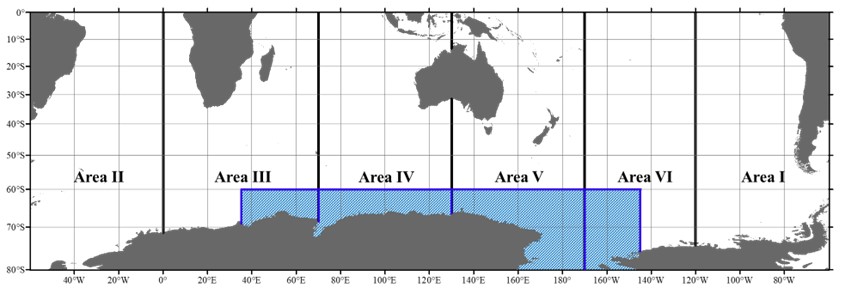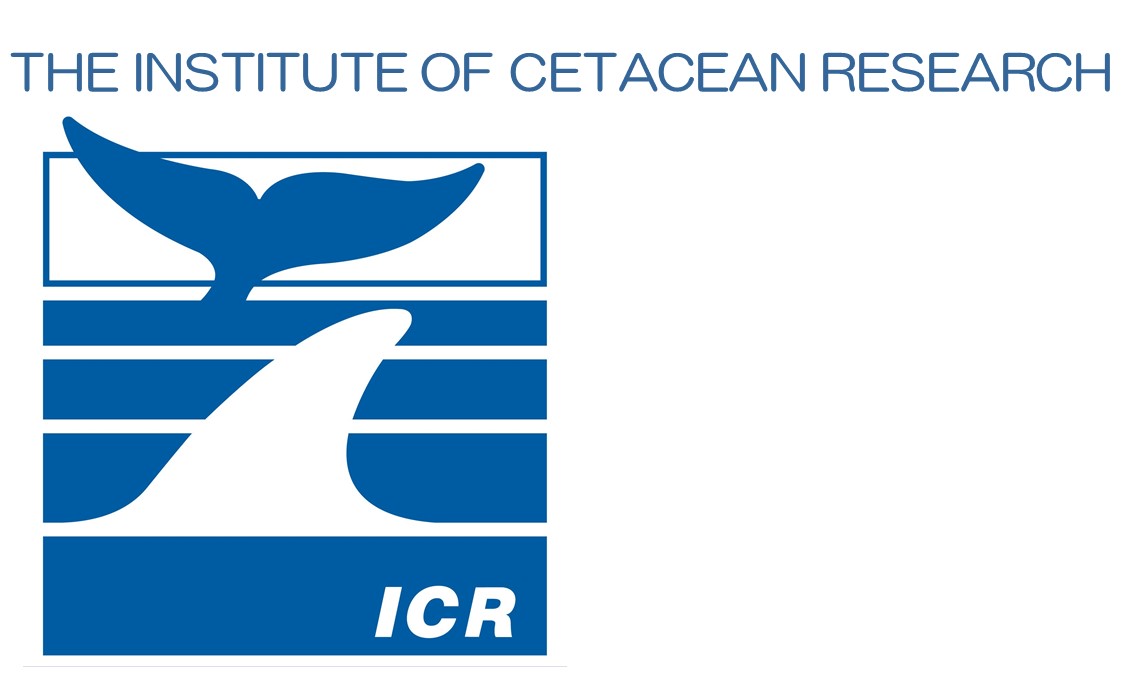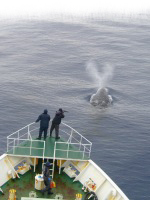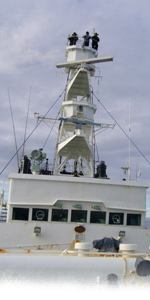- You are here:
- Home>
- English Sitemap>
- RESEARCH>
- Past Research>
- Antarctic Ocean>
- JARPA
JARPA outline
To resolve the scientific uncertainties associated with the implementation of the NMP, and to pave the way for the resumption of commercial whaling on Antarctic minke whales in a sustainable manner, Japan developed and implemented the research plan for the JARPA in 1987.
Objectives
Objective 1 (original objective in 1987)
Estimation of biological parameters to improve the stock management of the Southern Hemisphere minke whale
The original wording of this objective had been ‘estimation of biological parameters required for [emphasis added] the stock management of Southern Hemisphere minke whale’. However, this wording was changed to improve because of IWC Scientific Committee(SC)’s refocusing from the NMP towards the RMP as the basis for management.
This objective was established with the expectation that additional information on biological parameters (and knowledge of any changes in these) related to natural mortality rates at different age groups and age at attainment of sexual maturity of individuals, would reduce uncertainty and improve management of Antarctic minke whales under the NMP (and subsequently under the RMP via ISTs).
Objective 2 (original objective in 1987)
Elucidation of the role of whales in the Antarctic marine ecosystem.
This broad scale objective was established to begin to investigate the nature and changes in the Antarctic ecosystem especially in the context of whales. The Antarctic ecosystem is dynamic and Antarctic krill and fluctuations in its distribution and abundance are a vital driver in this dynamism since it is the main prey of several predators including marine mammals. This objective of JARPA was to examine possible changes in the Antarctic ecosystem through analyses of data on feeding and body condition of Antarctic minke whales in conjunction with information on the abundance (and any trends) of this and other large baleen whale species.
Objective 3 (new objective added in 1995)
Elucidation of the effect of environmental change on cetaceans.
This broad scale objective was added in response to the increasing IWC interest in the effects of environmental changes on cetaceans and an expansion of research related to the conservation of large whale stocks in the Southern Ocean.
Objective 4 (new objective added in 1996)
Elucidation of the stock structure of Southern Hemisphere minke whales to improve stock management.
This objective was established to investigate geographical and temporal boundaries of stocks based on biological evidence, and in particular examine the validity of the common boundaries of the existing general IWC Antarctic management Areas for baleen whales that were developed before Antarctic minke whales were a primary target species. Knowledge of population structure is essential to interpret data on: (a) the estimation of biological parameters (b) abundance estimates; and (c) designing ISTs and defining management areas for the application of the RMP.
Research area and period
JARPA began in the 1987/88 austral summer season as a two-year feasibility study that ICR considered a success and which led to the full program beginning in 1989/90 and completed in 2004/05 ? a total of some 18 years (including feasibility studies), always south of 60°S.
Initially JARPA operated each year alternating between IWC management Areas IV and V (see figure below). This was expanded from 1995/96 to include Area III East and Area VI West. Thus, for the rest of JARPA until its completion, JARPA covered Areas III East + IV and Areas V + VI West alternately each season. This longitudinal expansion was due to the initial results of stock structure analyses that suggested more than one stock in Areas IV and V. It allowed investigation of distribution and stocks boundaries.

Sample sizes and actual catches
The annual sample sizes and the actual catches of JARPA are shown in the table below.
| Season | Target ample size | Actual catches |
| 1987/88 (F) | 300+/- 10% | 273 |
| 1988/89 (F) | 300+/- 10% | 241 |
| 1989/90 | 300+/- 10% | 330 |
| 1990/91 | 300+/- 10% | 327 |
| 1991/92 | 300+/- 10% | 288 |
| 1992/93 | 300+/- 10% | 330 |
| 1993/94 | 300+/- 10% | 330 |
| 1994/95 | 300+/- 10% | 330 |
| 1995/96 | 400+/- 10% | 440 |
| 1996/97 | 400+/- 10% | 440 |
| 1997/98 | 400+/- 10% | 438 |
| 1998/99 | 400+/- 10% | 389 |
| 1999/00 | 400+/- 10% | 439 |
| 2000/01 | 400+/- 10% | 440 |
| 2001/02 | 400+/- 10% | 440 |
| 2020/03 | 400+/- 10% | 440 |
| 2003/04 | 400+/- 10% | 440 |
| 2004/05 | 400+/- 10% | 440 |
F: feasibility study.
Review of JARPA research proposals and results
The original JARPA research proposal was presented to the IWC SC in 1987 (Doc. SC/39/4) and a slightly revised plan was fully reviewed at a special intersessional meeting (Doc. SC/D87/1). The full-scale plan (i.e. after the feasibility study) was presented and reviewed by the IWC SC in 1989 (Doc. SC/41/SHMi13). The plans for the subsequent seasons from 1990/91 to 2004/05 were presented and reviewed annually by the IWC SC.
The review of proposals and research results was carried out using the ‘Old Review Procedure’, which was used before 2008. Under this procedure, review of proposals and results took place either during the annual meetings of the IWC SC or by holding intersessional review meetings or workshops open to participation by scientists from all Contracting Governments as well as invited participants.
The table below presents an overview of the review workshops by the IWC SC for research results of existing (1997) and completed (2006) JARPA based on the ‘Old Review Procedure’.
| JARPA | ||
| 1997 (Existing) | 2006 (Completed) | |
| Date | 12-16 May | 4-8 December |
| Place | Tokyo | Tokyo |
| Chair | Steve Reilly (USA) | Arne Bjorge (Norway) |
| No. Invited Participants | 8 | 13 |
| No. foreign delegates | 11 (Antigua and Barbuda, Dominica, Netherlands, New Zealand, Norway, St. Lucia, St. Vincent and the Grenadines, USA) | 12 (Australia, Germany, Grenada, Iceland, New Zealand, Norway, Republic of Korea, St. Lucia, USA) |
| No. Japanese scientists | 16 | 29 |
| No. local scientists | 7 | 0 |
| IWC Secretariat | 1 | 1 |
| No. primary documents | 23* | 32** |
| Reference | IWC, 1998 pp377 | IWC, 2008 pp409 |
*: five of those documents were prepared by foreign scientists.
**: one of those documents were prepared by foreign scientists.
International Whaling Commission. 1998. Report of the Intersessional Working Group to Review Data and Results from Special Permit Research on Minke Whales in the Antarctic, Tokyo, 12-16 May 1997. Rep. int. Whal. Commn 48: 377-412.
International Whaling Commission. 2008. Report of the Intersessional Workshop to Review Data and Results from Special Permit Research on Minke Whales in the Antarctic. J. Cetacean Res. Manage. 10 (Suppl.): 409-445.
The JARPA program started in austral summer seasons 1987/88 and 1988/89 as feasibility surveys.
The full program started in 1989/90,reviewed in 1997 by IWC/SC and was completed in 2004/05.
The main research objectives of JARPA were the estimation of biological parameters and the investigation of the stock structure of the Antarctic minke whale, which in conjunction with abundance data, were required for the IWC SC’s New Management Procedure (NMP).
Later this information while not with abundance data, were required for the IWC SC’s New required became important to improve the IWC SC’s Revised Management Procedure through the Implementation Simulation Trials.
JARPA had other two research objectives: the role of whales in the Antarctic ecosystem and the effect of environmental changes on cetaceans.
The maximum proposed annual sample size for the lethal component of the program was 440 animals.
The JARPA proposal and results were reviewed and commented on by the IWC SC through specific workshops and its annual meetings.




